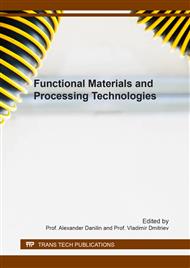p.1
p.7
p.14
p.31
p.37
p.51
p.60
p.71
On the Effect of Magnetic Fields on Electromigration Processes of Liquid Inclusions in Aluminum and Silicon
Abstract:
The substances move in conductors owing to drift of ions that occurs due to momentum exchange at collisions between the conductive carriers and atomic lattice. This effect is substantial at high-density direct currents, e.g., in power electronics. Therefore, the assigned subject matter is topical. The aim of this work is investigation of the effect of magnetic fields on electromigration processes of liquid inclusions in aluminum. We performed an analysis of formation and electromigration of molten Al-Si inclusions in silicon and aluminum crystals. It was found that molten inclusions 50-800 μm in size are formed in the studied system by contact melting in the 850-920 K temperature range. The electro-stimulated migration of inclusions along the electric lines of force at current densities j 4106 A/m2 was also established. From the dimensional dependence of specific velocity of travel w/j of molten Al-Si regions in silicon and aluminum, we made a conclusion concerning mechanisms of molten regions travelling. These are melting and crystallization at interphase boundaries due to thermoelectric phenomena and electromigration of atoms in the inclusion bulk. The numerical values of effective charges of Al and Si atoms in Al-Si melts as well as Peltier coefficients of the crystal-melt system were determined experimentally. It was found that preexposure of aluminum alloy (with iron concentration of ~0.6%) in a static magnetic field (В = 0.7 T) leads to changing of dimensional dependence of migration velocity of inclusions (i.e., it is magneto-sensing).
Info:
Periodical:
Pages:
31-36
Citation:
Online since:
November 2017
Price:
Сopyright:
© 2017 Trans Tech Publications Ltd. All Rights Reserved
Share:
Citation:


